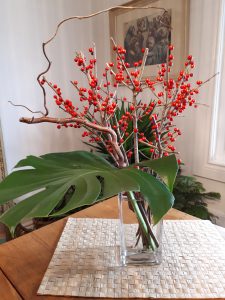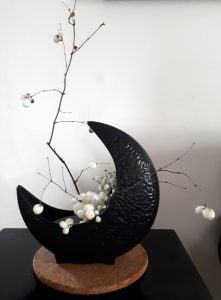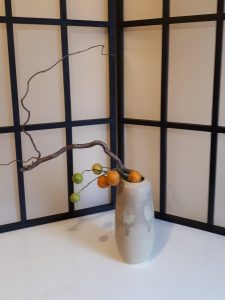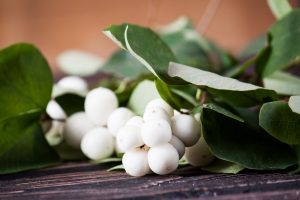In the Garden
By Claire McCaughey
Garden branches for indoor flower arrangements

In spring, summer and fall, you can make your own beautiful arrangements with a mix of flowers and flowering branches from the garden. Combinations of forsythia branches and tulips in the spring, cosmos and roses in summer, and black-eyed Susans and grasses in the fall all herald the season in the garden. But what about winter? Does the garden have anything to offer for flower arrangements?
When cold weather arrives, it may seem that there is little in the way of plant material to represent the special character of the season in an arrangement. Many people seek out branches at farmers’ markets in October and November for winter seasonal arrangements. These purchased branches are most often Cornus sericea (redtwig dogwood), Ilex verticillata (winterberry), and Salix matsudana (curly willow). These are indeed beautiful branches for indoor arrangements. However, they are not the only possibilities. There are other less commonly used branches to consider incorporating, some of which may be growing right in your own garden.
A branch of winterberry with many bright red berries, a single branch of contorted hazel and one Monstera leaf in a glass vase with crystal clear water.
Studying features of garden branches
Late fall is a good time to study the shrubs in your garden or perhaps in the wild and think about their potential for use in winter flower arrangements. What
are the unique characteristics of the branches you see? Branches are very versatile elements in indoor arrangements. Some have an attractive, unusual shape,
such as curly or contorted forms. Some have a colour that really stands out in the winter landscape. Redtwig or yellowtwig dogwood are prime examples of very
colourful branches, but there are also more subtle colours in branches such as pale grey, purple and tan. Interesting texture or surface such as peeling bark (birch—Betula nigra) or corky twigs (burning bush— Euonymus alatus) is another characteristic to look for. All these elements create interest and evoke the winter season when bare branches are combined with flowers.

Berries—the flowers of winter
Berries stand out in the early winter landscape, almost like flowers. In addition to Ilex verticillatan (winterberry), a popular choice for winter arrangements, there are other shrubs with berries. Cornus sericea (dogwood) has white berries, as does Symphoricarpos albus (snowberry). Mahonia aquifolium (Oregon grape) has bluish berries and evergreen to semi-evergreen leaves. These berries may not be present for long in the garden as they often serve as food for wildlife, but while they are still there, the branches can be cut to offer an interesting seasonal element in an indoor arrangement.
A single snowberry branch with a sprig of white-flowered baby’s breath in a dramatic but simple container.
Going minimalist with branches
Consider making simple, minimalist winter arrangements with just one or two branches from the garden and a few flowers or greens from the supermarket or florist. This style is often associated with and inspired by Ikebana, a Japanese art form that brings out the special character of seasonal branches and flowers. Ikebana arrangements usually include the three aesthetic elements of line, mass, and colour, all of which can be achieved when winter branches are arranged in a vase with one or two flower stems.
Minimalist arrangements can be made in simple glass containers so the characteristics of the branches can be clearly seen. A ceramic vase can be used to complement the branches and flowers. Good cut flowers to use with this kind of winter arrangement are Alstroemeria and Gerbera, both of which come in a
variety of colours such as red, yellow, orange, pink and white. The beauty of minimalist flower arrangements is that only a few stems are needed!

There are several things to keep in mind with minimalist flower arrangements.
First, use a vase or container with a narrow opening. This will help to keep the branches and flowers upright and closer together.
Second, if using a glass container, make sure that the water is always crystal clear. Either clear or coloured glass containers can be used.
Third, almost any style of vase or container is suitable, but keep in mind that a simple shape and design may work better with a minimalist arrangement.
Finally, less is more. One beautiful branch may be enough to make a statement with just one or two flowers.
One branch of contorted hazel with calamondin orange in a simple narrow-mouthed ceramic vase.
Claire McCaughey practises and teaches Ikebana (the Japanese art of floral design). She volunteers with Master Gardeners of Ottawa-Carleton.
Less common shrub branches for winter indoor flower arrangements indoors
Corylus avellana ‘Contorta’ (contorted hazel). This shrub, also known as Harry Lauder’s Walking Stick, has interesting, contorted branches. When dried, they can be combined with fresh flowers. The branches can be cut in early winter and brought indoors. Thicker branches are best for large arrangements, while shorter, thinner pieces can be included in small compositions.
Symphoricarpos albus (snowberry). This native shrub has slender, wiry twigs with large white berries. These branches are more delicate and are best used in a unique small vase or container. In addition to the white-berried snowberry, Symphoricarpos orbiculatus (coralberry) is a pink-berried species.

Physocarpus opulifolius (ninebark). This is a popular shrub with many cultivars, most with colourful leaves. When the leaves are gone in the winter, the feature that gives the shrub its common name becomes visible—namely, its peeling bark. The peeling bark has a subtle beauty, and the tall narrow bare branches provide a vertical element in arrangements.
Cornus alba ‘Budd’s Yellow’ or Cornus sericea ‘Flaviramea’ (yellowtwig dogwood). Cornus sericea (redtwig dogwood) is usually used for winter arrangements, but yellowtwig dogwood makes for an interesting twist. Various colours of dogwood branches used in combination are also effective.
Citrus mitis (calamodin orange). This is a houseplant citrus shrub that must come inside for the winter. This is not a common choice for a flower arrangement, but the small size of the fruits makes it suitable to include in arrangements. The small fruit-laden branches add a splash of colour.






